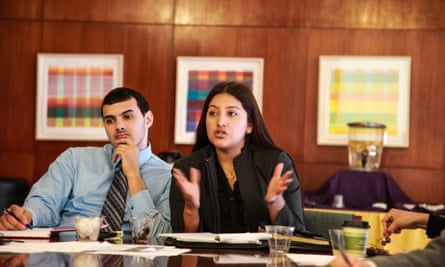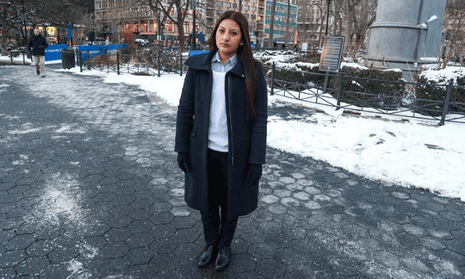On a recent bitterly cold afternoon, Monica Sibri hunches over her laptop in the College of Staten Island’s student center. Between constant phone calls, texts and emails, the senior student hardly manages to catch a breath.
She tends to every request before returning her attention to preparing talking points for a Latino civil rights conference she is attending the next day. Sibri, who is 22 and undocumented, says she manages 14- to 16-hour days. “I barely sleep,” she tells me in a rare pause from her duties.
Sibri is the chair and founder of the CUNY Dreamers, a citywide student group with chapters on many of New York City’s public university campuses dedicated to advocating for the rights of 6,000 undocumented students in the CUNY system. Some members of the group won a massive victory on Monday, as CUNY announced it was returning thousands of dollars to about 150 undocumented immigrant students who overpaid for their tuition.
Sibri started the group last year to provide students with a platform where they could learn their legal rights and procure the advocacy training she says is necessary to pass the state Dream Act in this year’s legislative session in Albany.
“Many people don’t understand what it means to be undocumented, and they don’t want to understand,” said Alondra Ramos, a member of CUNY Dreamers and a close friend of Sibri’s. “It’s up to us to always be one step ahead.”
The New York state Dream Act, which the state comptroller says would cost the state less than $20m per year, would allow some undocumented students in New York to access state financial aid and scholarships for higher education through the state’s Tuition Assistance Program, open accounts in its 529 college savings program, and raise private funds for a scholarship program for the college-bound children of immigrant parents.
The bill would not grant work permits or legal status, two issues that are central to undocumented students’ fundamental vulnerability: they are still “deportable and can’t work legally”, says Muzzaffar Chishti, an expert on US immigration policy who heads the office for the Migration Policy Institute, a thinktank at New York University School of Law.
“Only the federal government can dictate immigration policy,” said Chishti. “A Dream Act at the state level certainly has its benefits, like helping kids pay for school, and I don’t want to downplay that. But to celebrate this as a huge benefit that has long-lasting effects does a disservice to the Dreamers at the end of the day.”
If the bill passes, New York would become the sixth US state to allow undocumented students to access state-funded financial aid.

Both Democrats and Republicans are digging their heels for the legislative fight while the clock is ticking for thousands of undocumented students across the state who are wondering how they will pay next semester’s tuition, says Manny Castro, campaign coordinator at the New York Immigrant Coalition. Without access to state financial aid, Castro says, these students are excluded from a system that they and their parents have financially contributed to for years.
“So much has been invested in the lives of Dreamers by the state,” said Castro. “It then makes no sense for New York to be turning its back on these young people when they reach college, especially when they’ve done all that’s been asked of them.”
Cobbling together tuition: life savings, odd jobs and private scholarships
Sibri herself is undocumented, having arrived in New York City more than six years ago with her two younger sisters from her native Ecuador. For the three siblings, who lived with their grandparents and other family members for five years in Ecuador after their parents made the journey north in search of economic opportunity, immigration status was not something discussed at their home in Brooklyn’s Sunset Park, a largely working-class immigrant enclave with pristine cross-river views of the distant Manhattan skyline.
“It’s not something my parents felt comfortable discussing, so I had no idea I was undocumented, or what that even meant, until I started applying to colleges in my senior year of high school,” said Sibri. “I was told by my high school counselor and administrators that college would be fully out of pocket for me because I didn’t have papers. My grades didn’t matter, all that I had worked for until that point didn’t matter. That’s when I first felt that I was truly excluded from the system.”
Sibri gathered tuition money partially through her parents’ life savings, by working odd jobs off the books and from outside private scholarships. Others in her predicament have not been as fortunate. According to the New York State Youth Leadership Council, a New York City-based non-profit, of the estimated 4,500 undocumented students who graduate high school every year in New York state, only 5-10% of them pursue college study due to the tremendous financial burden on their families.
For many, like Mehdi Mahraoui, college usually isn’t even an option. The story of how the 24-year-old native from Morocco got to CUNY’s John Jay College in Manhattan is, he says, “a miracle”.
He was brought to the US by his parents at the age of seven, along with his two younger sisters; his parents sold away all their possessions in Casablanca and bought one-way plane tickets to New York to try their luck in America.
Years later, as a high school senior in Queens’ Far Rockaway neighborhood, Mahraoui was a few months away from graduating and knew college was financially out of the question. He was a member of his school’s rowing team, and his coach approached him after practice one day and asked him where he was looking to attend university. Embarrassed, Mahraoui was forced to explain to his coach that his undocumented legal status prohibited him from accessing the crucial financial aid that would make it possible for him to continue his studies.
Once word spread of his situation, Mahraoui’s team-mates began soliciting donations. They asked strangers on subway cars, at bus stops, outside bodegas. Overall, they raised over $2,000 in their efforts, which covered Mahraoui’s first semester at John Jay.
Since then, like Sibri, he has stayed in school by working off the books and earning outside private scholarships. His improbable story reached the White House, who invited him and six other Dreamers from across the country to a May 2014 private meeting with President Obama, Vice-President Biden and aides.
“It was a weird feeling, because being undocumented in this country you feel like you’re just a nameless, faceless statistic,” said Mahraoui. “But here we were, sharing our stories with the president. I felt for the first time that my story meant something.”
Looking to the future
Last week, around 20 Dreamers from across the state convened at the University of Albany for the first annual New York Dreamers Conference. The students, who hailed from both CUNY Dreamers and SUNY Dreamers – a sister organization that covers the state’s public university system outside New York City – had just finished a whirlwind weekend of lobbying Republican and Democratic lawmakers in the state legislature at the capitol to support the Dream Act.
The mood in the room was upbeat, but the students recognized the very real political obstacles facing the bill. For most of the group, though, there was still hope if the bill failed: an overwhelming majority of them qualify for Obama’s expanded Deferred Action for Childhood Arrivals, or Daca, program, which he announced last November along with an expansion to the Deferred Action for Parents of Americans, or Dapa. The actions would grant temporary legal status to as many as 5 million undocumented immigrants across the country, including an estimated 600,000 newly eligible Dreamers across the country.
Sibri, the leader and voice of their movement, does not qualify. She came to the US at 16 years and four months of age, just missing the 16-year-old cutoff for eligibility. She is left out.
Still, she says she is ecstatic for her friends and family and will continue to fight for comprehensive reform in the nation’s broken, complex immigration system.
“I devote my time to helping others because I know how it feels to have nobody to rely on,” said Sibri. “The Dreamers are my network of support and I advocate for them so that one day they will do the same.”

Comments (…)
Sign in or create your Guardian account to join the discussion